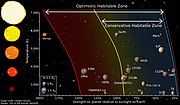 | In astronomy and astrobiology, the habitable zone (HZ), or more precisely the circumstellar habitable zone (CHZ), is the range of orbits around a star... 134 KB (13,621 words) - 17:05, 13 April 2024 |
 | A Habitable Zone for Complex Life (HZCL) is a range of distances from a star suitable for complex aerobic life. Different types of limitations preventing... 52 KB (5,804 words) - 12:33, 30 April 2024 |
 | atmosphere and geology. Of the natural satellites in the Solar System's habitable zone – the Moon, two Martian satellites (though some estimates put those... 37 KB (3,721 words) - 03:57, 3 May 2024 |
 | the only ones in which the habitable zone coincides completely with the ultraviolet habitable zone. Since the habitable zone is farther away in more massive... 35 KB (3,485 words) - 23:02, 3 May 2024 |
 | Exoplanet (redirect from Habitability of exoplanets) zone. In several cases, multiple planets have been observed around a star. About 1 in 5 Sun-like stars have an "Earth-sized" planet in the habitable zone... 146 KB (15,825 words) - 13:36, 5 May 2024 |
 | K2-18b (category Super-Earths in the habitable zone) 6 times the radius of Earth, with a 33-day orbit within the star's habitable zone. This means it receives about a similar amount of starlight as the Earth... 40 KB (4,636 words) - 04:47, 3 May 2024 |
 | such as the extreme temperature differences created by one side of habitable-zone planets permanently facing the star, and the other perpetually turned... 52 KB (6,389 words) - 16:48, 11 March 2024 |
 | Kepler-452b (category Super-Earths in the habitable zone) 01) is a super-Earth exoplanet orbiting within the inner edge of the habitable zone of the sun-like star Kepler-452 and is the only planet in the system... 18 KB (1,746 words) - 18:10, 3 May 2024 |
 | Super-Earth (section First in habitable zone) super-Earths within the Gliese 581 planetary system, both on the edge of the habitable zone around the star where liquid water may be possible on the surface. With... 62 KB (7,132 words) - 00:42, 2 May 2024 |
 | Planetary system (redirect from Venus zone) difficult to observe. Of particular interest to astrobiology is the habitable zone of planetary systems where planets could have surface liquid water,... 47 KB (5,449 words) - 19:57, 3 May 2024 |
 | others, a galactic habitable zone; a central star and planetary system having the requisite character (i.e. a circumstellar habitable zone); a terrestrial... 102 KB (11,807 words) - 20:32, 3 May 2024 |
 | only current example of a habitable planet. At a distance of 1 AU from the Sun, it is within the circumstellar habitable zone of the Solar system, which... 47 KB (5,437 words) - 03:18, 3 March 2024 |
 | Kepler-186f (category Exoplanets in the habitable zone) designation KOI-571.05) is an Earth-sized exoplanet orbiting within the habitable zone of the red dwarf star Kepler-186, the outermost of five such planets... 32 KB (3,073 words) - 03:05, 9 April 2024 |
TOI-2257 b (section Habitability) extremely eccentric (0.496) exoplanet in or near the circumstellar habitable zone of the star TOI-2257, 188 light-years away. It is likely a sub-Neptune... 11 KB (1,243 words) - 17:04, 8 January 2024 |
planetary habitability is complex and defined by several factors. Being in the habitable zone is not enough for a planet to be habitable, not even to... 114 KB (13,266 words) - 14:18, 4 May 2024 |
 | Red dwarf (section Habitability) Gliese 581d, which is also potentially habitable, was discovered. Gliese 581c and d are within the habitable zone of the host star, and are two of the most... 36 KB (4,242 words) - 21:49, 3 May 2024 |
 | TRAPPIST-1 (section Habitable zone) habitable zone has led to an increase in studies on planetary habitability. The planets are considered prototypical for the research on habitability of... 179 KB (19,770 words) - 06:09, 5 May 2024 |
 | Kepler-442b (category Near-Earth-sized exoplanets in the habitable zone) confirmed near-Earth-sized exoplanet, likely rocky, orbiting within the habitable zone of the K-type main-sequence star Kepler-442, about 1,206 light-years... 18 KB (1,781 words) - 12:45, 7 April 2024 |
 | Earth analog (category Planetary habitability) Saturn's moon Titan to be one of the most Earth-like worlds outside of the habitable zone. Though having a dramatically different chemical makeup, discoveries... 38 KB (3,892 words) - 01:42, 29 March 2024 |
 | Kepler-22b (category Exoplanets in the habitable zone) Interest designation KOI-087.01) is an exoplanet orbiting within the habitable zone of the Sun-like star Kepler-22. It is located about 640 light-years... 19 KB (1,839 words) - 20:18, 3 May 2024 |
 | has two confirmed planets: Proxima b, an Earth-sized planet in the habitable zone discovered in 2016, and Proxima d, a candidate sub-Earth which orbits... 113 KB (11,050 words) - 01:09, 3 May 2024 |
 | Kepler-62f (category Super-Earths in the habitable zone) designation KOI-701.04) is a super-Earth exoplanet orbiting within the habitable zone of the star Kepler-62, the outermost of five such planets discovered... 24 KB (2,430 words) - 15:20, 4 January 2024 |
will be optimized to search for and image Earth-size habitable exoplanets in the habitable zones of their stars, where liquid water can exist, by using... 5 KB (434 words) - 17:16, 3 May 2024 |


